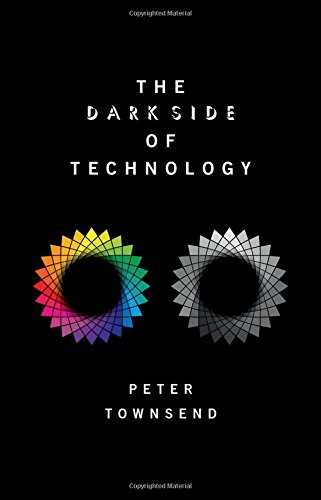Will We Survive This Century?
Our collective ability to overcome a host of existential threats is the subject of two 2017 books. Is humanity doomed, or do we have reason to be hopeful?
Surviving the 21st Century: Humanity’s Ten Great Challenges and How We Can Overcome Them
Julian Cribb. 2017. Springer International Publishing, Switzerland. 255 pages.
The Dark Side of Technology
Peter Townsend. 2017. Oxford University Press, Oxford. 319 pages.
For the past 50 years and more, prescient authors have warned about existential threats to the global community, including numerous environmental issues. They have detailed the kinds of problems that should cut across all the usual divisions of society and give us the universal jolt we need to work together to survive. That’s what such authors hope to achieve by their work. To what degree have they succeeded, and is there light at the end of the tunnel?
The modern environmental movement to preserve and protect the health of the planet gained momentum in the 1960s. Building on immediate postwar fears of overpopulation and resource depletion, the idea that the earth and its civilization should be economically and environmentally sustainable became paramount.
Rachel Carson’s Silent Spring (1962) alerted many to the danger of the careless application of synthetic pesticides. Much to the dismay of chemical companies, it led to a nationwide US ban on the use of DDT in agriculture.
The work of a Nobel nominee in both economics and peace, Kenneth Boulding, includes his acclaimed book The Meaning of the Twentieth Century: The Great Transition (1964). He saw the road ahead in terms of moving successfully past the 20th century’s environmental and economic problems to a social order characterized by nonpolluting, resource-sensitive, sustainable high technology. To achieve this, new approaches to aesthetics and resolving human relationship issues would be necessary. An observant Quaker, Boulding’s religious orientation was his firm bedrock. He believed in “the immediate experience of the Holy Spirit, or Inward Light, available to every man to teach, guide, reprove, and draw him up toward goodness.”
Biologist Paul Ehrlich’s The Population Bomb (1968) introduced the frightening idea that the rate of human population growth at the time would bring on mass starvation within a decade. Though he was proven wrong in his timing, he still believes that overpopulation remains a major global challenge. In 1972, the Club of Rome, a European think tank, published The Limits to Growth, a nontechnical version of an MIT study of the implications of continued worldwide economic and population growth. It concluded that the trajectory could not be sustained beyond 2100, if that long. Other luminaries of those days included inventor and designer Buckminster Fuller, biologist Barry Commoner, writer and economist Barbara Ward, and microbiologist René Dubos. Economist E.F. Schumacher’s Small Is Beautiful (1973) laid bare six fundamentally flawed ideas that have powered the modern world. His proposals for an economic order to function “as if people mattered” presented the growing problems of gigantism and the coming globalization, and promoted the idea that small-scale, localized economics in sync with the slower natural rhythms of human life would answer the burgeoning environmental and social crises. Schumacher had journeyed through capitalism to communism, from Buddhism to Catholicism, to arrive at his spiritually oriented conclusions.
While such works have brought about much change, many of the threats they highlighted are still front and center. The questions surrounding limits, pollution, agrochemical dependency, overuse of fossil fuels, resource depletion, and industrialization in the developing world remain, but now the hour is late, and our existential and environmental problems are more numerous and of greater magnitude.
Enter some of this century’s writers. Two of the most recent works to address existential threats are by science author Julian Cribb and engineering physics professor emeritus Peter Townsend.
Cribb’s Surviving the 21st Century details 10 great challenges to humanity: mass extinction, resource depletion, weapons of mass destruction, climate change, universal toxicity, food crises, population and urban expansion, pandemic disease, dangerous new technologies, and self-delusion. Along with extensive up-to-date factual support for his survey, Cribb provides helpful global and personal to-do lists for each peril. Neither international organizations and governments nor individuals escape without knowing their responsibilities.
“Only a fool would imagine we can keep on behaving as we do today when there are ten billion of us, without grave risk to our entire civilisation and maybe our species.”
In The Dark Side of Technology Townsend touches on many of the same threats, but he adds the potential loss of electronically stored knowledge as a significant danger. Recognizing that “technology is the keystone to our progress,” he also examines the disadvantages that advanced technology brings in its wake. His intent is “to promote a realization of how our lives have been altered and controlled, even in subtle ways, by the advances in science and medicine” and to “recognize . . . and attempt to solve” the problems caused by advanced technology. In doing so, Townsend offers a far more personalized account of the dangers facing us than Cribb does. This is not necessarily a better way to alert us, however; written in the first person, it sounds too much like personal opinion in places. On the other hand, Cribb’s depth of research support lends great credibility.
That said, we limit our review to two of the critical challenges facing humanity: species extinction and weapons of mass destruction (WMD). Cribb’s remaining eight threats will feature in upcoming issues of Vision.

Dying Off
Townsend notes that the International Commission on Stratigraphy, among whose objectives is the standardizing of a geologic time scale, is proposing that Earth has entered a new epoch to be named the Anthropocene. The switch from the present Holocene is necessary, they say, because the results of human dominance can be seen everywhere on the planet. This has led to irreversible changes, which could in turn bring 75 percent of all species to extinction. According to Townsend, “we ignore their extinctions in our rush forward for personal or corporate gain. Our actions are frequently blinkered and self-centred, even in farming and fishing, which we need for our survival.” Townsend’s hope is that we can opt for an evolutionary change from Homo sapiens (Latin: “wise man”) to Caring And Scientific Humans (CASH—an acronym, he notes, that may appeal to politicians and industrialists). Yet as we will see, this kind of optimism begs some fundamental questions about human nature, as both writers readily observe.
Cribb deals with species die-off in much greater detail, and it is the present rate of extinction that gives reason for concern. Extinction is part of life on earth. The dinosaurs and the mammoths came and went; we lost the dodo in the 17th century and the passenger pigeon in the early 20th. But today a host of species including birds, fish, invertebrates, mammals, plants, fungi, reptiles and amphibians show signs of impending extinction. The normal or “background” extinction rate of one species per year (the rate at which species would disappear in the absence of humans or extraordinary events such as an asteroid strike) is being greatly exceeded in the 21st century. In the case of amphibians, the rate has slowed; yet it is still 25,000–45,000 times the background rate. Of the 6,300 known varieties of amphibian, Cribb reports, about one third are endangered or already extinct. Frogs, toads, and salamanders are very sensitive to changes in the environment; they are “the canary in the planet’s coal mine,” the earth’s early warning system of a mass extinction that may eventually claim most species, including us.
The major causal factor in this horrifying rate of destruction is man himself. We are the ones bringing about this massive change—a possible sixth extinction. From pollution of air, water and soil, to pesticide use, loss of species habitats, and overharvesting, human encroachment is disrupting the cycles of nature on which we ourselves depend.
“That humans are implicated in the dramatic acceleration in loss of species now being seen around the world is no longer doubted by the tens of thousands of researchers who study the issue.”
Cribb quotes various researchers to back up his position: first, a 2014 report by Rodolfo Dirzo and colleagues, published in the journal Science, which summarizes, “In the past 500 years, humans have triggered a wave of extinction, threat, and local population declines that may be comparable in both rate and magnitude with the five previous mass extinctions of Earth’s history”; and famed biologist E.O. Wilson, who says, “We are tearing down the biosphere. Without abatement, the current rate of human activity will result in as many as half the species of plants and animals being extinct or on the brink of extinction by the end of the century. I don’t think the world can sustain this. It really will be forever.”
Massively Destructive Weapons
The dark side of technology makes possible the military or terrorist use of nuclear, chemical and biological weapons and the near annihilation of humanity through the immediate death of many and the starvation that would follow for others. The natural world we have known would disappear for eons.
Townsend is right to remind us that “warfare is enabled by modern technology, the very dark side of which is damage to the entire fabric of future world civilization,” and that it is not just the ultra pessimist who raises such concerns. Even cosmologist and British Astronomer Royal Sir Martin Rees and others, who have written carefully reasoned arguments about this potential, warn of a dire outcome. In an interview with Vision about our fragile future (following the release of his 2003 book, Our Final Century: Will the Human Race Survive the Twenty-First Century?), Lord Rees remarked, “I think there is a 50 percent chance that in the coming century civilization will suffer a setback as bad as a catastrophic nuclear war.”
Cribb cites the work of the Stockholm International Peace Research Institute (SIPRI) to support his section on the perils of the human militant spirit. Noting that in 2015 the world powers’ military spending amounted to $1.7 trillion, whereas global investment on agricultural science totaled approximately $50 billion, he suggests that a new definition of humanity might be “a species which spends 34 times more on better ways to kill itself than it does on better ways to feed itself.”
Any ultimate doomsday projection will specify several possible initial triggers. As we know, many of the threats looming over the 21st century are interrelated. Factors that could lead to catastrophic war include resource depletion through overuse, food and water insecurity, refugee influx, climate change, and pandemics.
Pushed to the limits, any one of today’s nine nuclear nations could set off the final conflagration. Their combined known nuclear arsenals amount to an estimated 15,000 weapons and decommissioned warheads. Though this is a significant reduction from the 60–70,000 total during the Cold War, it is still enough to terminate humanity several times over. And this accounting does not include the planned upgrades of nuclear weapons by several nuclear powers over the next decade. Add to this the uncertainty created by the rogue nuclear nation of North Korea, the hard-pressed Israeli nation (with an estimated 80 warheads), the opaque Iranian nuclear program, and the tense Pakistan-India relationship (estimated to have 110–140 weapons each). In addition, the International Atomic Energy Agency’s Incident and Trafficking Database details significant amounts of lost and/or stolen plutonium and highly enriched uranium. The possibility of terrorist possession of missing weapons and/or fissionable material gives yet another dimension to the reality of an atomic doomsday scenario.
Is There Hope?
Considering the two threats of mass extinction and WMD and the mounting evidence of their salience, one might conclude that there is little hope. Yet both authors would stake a claim for optimism. Pinning his hope on a view of humanity as a species that has demonstrated great survivability, Townsend writes, “By nature I am definitely optimistic, and therefore convinced (by instinct, not evidence) that humanity will survive even major disasters, and we will eventually evolve into a humanoid form that differs from our present model—in other words, the same pattern of evolution as has happened over the last tens of thousands of years.”
“Civilization as we currently know it will certainly alter.”
Cribb’s view is related. His book begins with a fictional account of African prehuman use of fire to ward off attacking predators and later to cook food. These two skills he takes to be an example of the critically important development of foresight, something that distinguishes modern humans from animals. It is to this foresight and the wisdom it confers that he appeals in laying out the existential threats we face: “Wisdom, not knowledge or technology alone, will decide whether we survive and prosper . . . or whether we all go down in darkness, another evolutionary dead end . . . lacking the foresight to avoid our own, self-ordained, fate.”
Cautiously optimistic, these authors nevertheless admit that we may not make use of our unique human traits that militate against extinction. Our ability to learn and pass on our knowledge through spoken and written language, our foresight, our acquired wisdom, our ability to invent technologies may not be enough. Townsend comments, “I also recognize that we have advanced technologically precisely because of, not just intelligence, but the human characteristic features of aggression, power seeking, and personal gain. That part of humanity is unlikely to change.” And while Cribb is hopeful that “the linking of minds, values, information and beliefs at light-speed and in real time, around the planet” will overcome the threats, he also says, “As a species we are not wise. We are not smart. We may not even be intelligent enough to ensure our own long-term existence. That remains to be seen.”
Another Perspective
Both authors, like others before them, have taken a position on religion in examining the threats facing humanity. Townsend focuses on the religious impulse to say that “all events are an act of God” and by doing so avoid responsibility to make the necessary changes. Similarly, Cribb mentions the religious cop-out, embodied in the “God will save us” option, as “an abrogation of personal responsibility for one’s own, and one’s children’s fate, and as such unlikely to please any deity.”
E.F. Schumacher’s position was very different. Rather than passing blithely over religion as offering any answers, he called on “our great classical-Christian heritage” to provide what he regarded as missing in modern life. He saw the spiritual truths embodied in the New Testament’s Gospels as essential knowledge in an age of excess: “There could not be a more concise statement . . . of our situation, than the parable of the prodigal son. Strange to say, the Sermon on the Mount gives pretty precise instructions on how to construct an outlook that could lead to an Economics of Survival.” The story of the prodigal son is a salutary tale of waste (prodigality), of repentance and redemption, of physical excess and spiritual access. The wastrel son comes home to forgiveness and new life. And Jesus’ great moral discourse on the mountain is about discovering the spiritual qualities essential to living this life in balance and measure, with respect for God and His creation, including fellowman. Schumacher summarized it this way: “There is a revolutionary saying that ‘Man shall not live by bread alone but by every word of God.’”
What is intriguing about the secular analyses of Cribb and Townsend is that the seriousness of the problems they highlight, the human nature they recognize and regret, and the optimism they express, are all subjects the Bible discusses in some detail. Thus, their overall rejection of religion as a source of answers is shallow and unnecessarily dismissive.
Consider the following: Jesus spoke of a coming time when all life on earth would be in danger of annihilation and yet rescued (Matthew 24:21–22); the core New Testament message explains how change in our fundamentally flawed human nature is effected (Romans 8:1–4; Hebrews 8:8–12); there will be an eventual long-term positive outcome for all humanity (Romans 8:18–21). Are not these the same problems and opportunities to which the two authors draw our attention? The difference is that the spiritual resolution promises the success that we alone cannot achieve.




